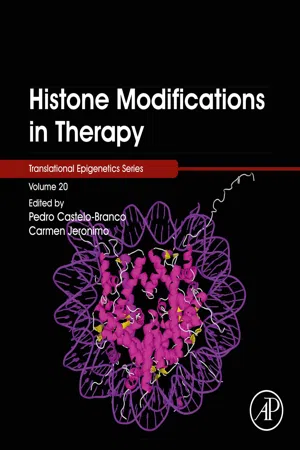1.1: The basics of histone modifications
Misregulation of gene expression is implicated in the pathogenesis of diverse human diseases.1 It can be triggered by genetic alterations, including gene mutations, amplifications, and translocations, and epigenetic alterations, which are also inherited but do not involve changes in the DNA sequence. In fact, a growing body of evidence suggests that epigenetic alterations, affecting mainly noncoding RNAs, DNA methylation, and posttranslational histone modifications, can significantly modify pivotal transcriptional programs.1,2 Both DNA methylation and histone modifications modulate gene expression chiefly because they impact the chromatin structure.3,4
Chromatin is the DNA–protein complex found in the eukaryotic cell nucleus, and its primary function is packaging DNA molecules into a more compact, denser shape. The basic repeating unit of chromatin is the nucleosome, which is composed of 146 base pairs of DNA wrapped around an octamer containing two of each core histone H2A, H2B, H3, and H4.5,6 DNA is negatively charged due to the phosphate groups in its phosphate-sugar backbone. However, the amino acids lysine and arginine are preponderant in each of the core histones, and their positive charges can effectively neutralize the negatively charged DNA backbone, making the interaction between histones and DNA very tight.5 Nucleosomes are then connected by a linker DNA of varying length, which is further folded into arrays with the aid of the linker histone H1 and nonhistone proteins to form a 30-nm chromatin fiber.6–8 This ordered structure enables the necessary compaction to fit the large eukaryotic genomes inside the cell nuclei,9 prevents DNA damage, and regulates DNA replication, cell division, and gene expression.10,11
Gene expression requires the two strands of DNA to separate temporarily, allowing the access of enzymes involved in transcription to the DNA template. Therefore, although compact, the structure of chromatin must be highly dynamic, switching between an “open” and a “closed” state that regulates the access to the underlying DNA in interphase. Where the chromatin is loosely organized, it is more accessible for transcription and is referred to as euchromatin. However, chromatin can also be highly compacted and inaccessible for transcription in a “closed” or inactive state, the so-called heterochromatin. Therefore genes are coordinately activated or repressed to ensure cellular homeostasis where the chromatin switches between euchromatin and heterochromatin.6
In addition to some spontaneous DNA unwrapping and rewrapping in the nucleosome, there are other relevant mechanisms to allow access to the DNA by modulating the chromatin structure. First, chromatin structure is thought to be influenced by DNA methylation, the most abundant epigenetic modification, which involves the addition of a methyl group to the cytosine pyrimidine ring in CpG dinucleotides by DNA methyltransferases (DNMTs). Although the mechanisms involved remain largely unknown,12 DNA methylation has been associated with nucleosome positioning/remodeling,13 the recruitment of methyl-binding domain proteins (MBDs),14 and the binding of CTCF factors,15 thus modifying the chromatin structure. Second, and more important in the context of this book, core histone modifications are pivotal to chromatin structure and dynamics. Histone modifications also work jointly with DNA methylation for repression of gene loci.16,17
Histones are a family of small, positively charged proteins, which are among the most highly conserved eukaryotic proteins. As previously mentioned, the core histones are responsible for the chromatin packing in nucleosomes. These are composed of two main domains: the histone fold that is inserted in the nucleosome and is important for histone/histone and histone/DNA interactions, and an N-terminal tail, which extends out from the DNA–histone core.5 The histone tails are subject to several different types of enzyme-catalyzed, posttranslational covalent modifications on specific residues that alter their interaction with DNA and nuclear proteins and, in turn, control critical aspects of chromatin structure and function.
The most well-studied types of histone modifications are methylation, acetylation, phosphorylation, and ubiquitination.18 All these types of modifications are reversible, with one highly specific enzyme serving to create a particular type of modification and another to remove it. These enzymes are recruited to specific sites in the chromatin.
Histone methylation involves the addition of one, two, or three methyl groups to lysine residues, and one or two methyl groups to arginine residues. Methyl groups can be added by a set of different histone methyltransferases (HMTs) and removed by histone demethylases (HDMs). Histone methylation in specific lysines and arginines has been reported to regulate gene expression, either promoting or counteracting it, in different settings.19 For example, trimethylation of histo...
